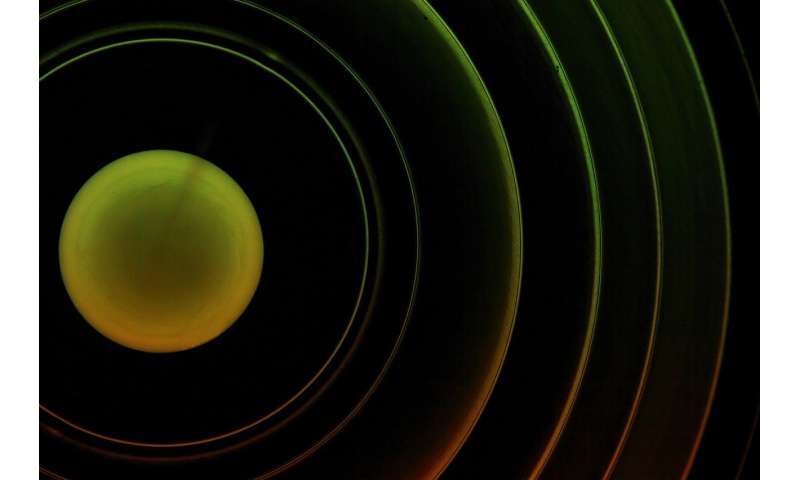
Like Bigfoot and the Loch Ness monster, critical spin fluctuations in a magnetic system haven't been captured on film. Unlike the fabled creatures, these fluctuations—which are highly correlated electron spin patterns—do actually exist, but they are too random and turbulent to be seen in real time.
A Cornell team developed a new imaging technique that is fast and sensitive enough to observe these elusive critical fluctuations in two-dimensional magnets. This real-time imaging allows researchers to control the fluctuations and switch magnetism via a "passive" mechanism that could eventually lead to more energy-efficient magnetic storage devices.
Radical Collaboration
The team's paper, "Imaging and Control of Critical Fluctuations in Two-Dimensional Magnets," published June 8 in Nature Materials.
The paper's co-senior authors are Kin Fai Mak, associate professor of physics in the College of Arts and Sciences, and Jie Shan, professor of applied and engineering physics in the College of Engineering. Both researchers are members of the Kavli Institute at Cornell for Nanoscale Science, and they came to Cornell through the provost's Nanoscale Science and Microsystems Engineering (NEXT Nano) initiative. Their shared lab specializes in the physics of atomically thin quantum materials.
Magnetization fluctuations are considered "critical" when they occur near the thermodynamic critical point, which is the moment when a form of matter transitions into a new phase, giving rise to all sorts of unusual phenomena. A typical example is iron, which loses its magnetic properties when heated to extreme temperatures.
In this critical region, or regime, the fluctuations stop behaving randomly and instead become highly correlated.
"If you imagine all air molecules correlated, they're moving together on a very large length scale as wind," said Chenhao Jin, a postdoctoral fellow with the Kavli Institute and the paper's lead author. "That's what happens when the fluctuation becomes correlated. It can lead to dramatic effects in a system and at any scale because the correlation, in principal, can go to infinity. The fluctuation we are looking at here is the spin, or magnetic moment, fluctuations."
These critical magnetization fluctuations are difficult to see because they are constantly changing and occur in a very narrow temperature range.
"Physicists have studied the magnetic phase transition for many decades, and we know this phenomena is more easily observed in a two-dimensional system," Mak said. "What is more two-dimensional than a magnet that has only a single layer of atoms?"
Observing a signal from a single atomic layer still presents plenty of challenges. The researchers used a single-layer ferromagnetic insulator, chromium bromide, which as a two-dimensional system features a wider critical regime and stronger fluctuations. In order to see these fluctuations in real time, the researchers needed a method that was equally fast, with a high spatial resolution and wide field-imaging capability.
The team was able to meet those criteria by using light with a very pure polarization state to probe the monolayer and record a clean signal of the magnetic moment—which is the strength and orientation of the magnet—as it makes its spontaneous fluctuations.
The ability to capture this phenomena in real time means the researchers can control the critical fluctuations in the magnet simply by applying a small voltage and letting the fluctuations toggle back and forth between states. Once the targeted state or value has been achieved, the voltage can be turned off. No magnetic field is needed to control the fluctuations because they essentially drive themselves. This could potentially lead to the creation of magnetic storage devices that consume much less energy.
"It's a fundamentally different concept from active magnetic state switching, because it's totally passive," Mak said. "It's a switching based on the information gained from measurements, rather than actively driving the system. So it's a new concept that could potentially save lots of energy."
Citation: Researchers control elusive spin fluctuations in 2-D magnets (2020, June 29) retrieved 29 June 2020 from https://ift.tt/2AeDAXX
This document is subject to copyright. Apart from any fair dealing for the purpose of private study or research, no part may be reproduced without the written permission. The content is provided for information purposes only.
"control" - Google News
June 29, 2020 at 11:22PM
https://ift.tt/2AeDAXX
Researchers control elusive spin fluctuations in 2-D magnets - Phys.org
"control" - Google News
https://ift.tt/3bY2j0m
https://ift.tt/2KQD83I
Bagikan Berita Ini















0 Response to "Researchers control elusive spin fluctuations in 2-D magnets - Phys.org"
Post a Comment